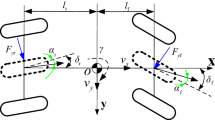Abstract
Autonomous emergency braking (AEB) has drawn a lot of attention as an active safety system preventing rear-end collision avoidance when the relative speed between vehicles is slow. To increase the operation range of current AEB system, this paper suggests a collision avoidance strategy using steering and braking simultaneously with nonlinear model predictive control (NMPC) method. The NMPC predicts the vehicle’s future trajectory with its open-loop dynamics and calculates the error between the predicted and the desired paths. Then NMPC calculates the control inputs such as the wheel steering angle and vehicle acceleration by optimizing the cost function over future receding horizon with predetermined constraints. In this paper, constraints on the wheel steering angle is proposed in consideration of vehicle’s predicted lateral acceleration, which should be smaller than the threshold in order to maintain lateral vehicle’s stability. To verify the performance of the proposed strategy, two simulation scenarios were tested in MATLAB and CarSim simulation environments.
Similar content being viewed by others
References
T. Lich, A. Mettler, A. Georgi, C. Danz. D. Lee, and S. Lee, “Benefit analysis of predictive rear end collision avoidance and mitigarion systems for South Korea using video documented accident data,” Proc. of International Symposium on Advanced Vehicle Control(AVEC), 2012.
R. Schram, A. Williams, M. van Ratingen, “Implementation of autonomous emergency braking the next step in Euro Ncap’s safety assessment,” Proc. of 23rd International Technical Conference on the Enhanced Safety of Vehicles (ESV), 2013.
A. Eckert, B. Hartmann, M. Sevenich, and P. E. Rieth, “Emergency steer & brake assist -a systematic approach for system integration of two complementary driver assistance system,” Proc. of 22nd International Technical Conference on the Enhanced Safety of Vehicles (ESV), 2011.
www.nissan-global.com, 2012 News releases of Autonomous Emergency Steering System.
Y.S. Son, W. Kim, S. Lee, and C. C. Chung, “Predictive virtual lane method using relative motions between a vehicle and lanes,” International Journal of Control, Automation and Systems, vol. 13, no. 1, pp. 146–155, Feb. 2015. [click]
C. Chen and H. Tan, “Steering control of high speed vehicles: dynamic look ahead and yaw rate feedback,” Proc. of the 37th IEEE Conference on Decision and Control, pp. 1025–1030, 1998
A. Vahidi and A. Eskandarian, “Research advances in intelligent collision avoidance and adaptive cruise control,” IEEE Trans. On Intelligent Transportation Systems, vol. 4, no. 3, pp. 143–153, 2003.
R. Isermann, M. Schorn, and U. Stählin, “Anticollision system PRORETA with automatic braking and steering,” Vehicle system Dynamics: International Journal of Vehicle Mechanics and Mobility, vol. 46, pp. 683–694, 2009.
R. Hayashi, J. Isogai, P. Raksincharoensak, and M. Nagai, “Autonomous collision avoidance system by combined control of steering and braking using geometrically optimized vehicular trajectory,” Vehicle system Dynamics: International Journal of Vehicle Mechanics and Mobility, vol. 50, pp. 151–168, 2012. [click]
T. Hesse and T. Sattel, “An approach to integrate vehicle dynamics in motion planning for advanced driver assistance systems,” IEEE Intelligent Vehicles Symposium, pp. 1240–1245, 2007.
C. Choi, Y. Kang, and S. Lee, “Emergency collision avoidance maneuver based on nonlinear model predictive control,” Proc. of IEEE International Conference on Vehicle Electronics and Safety, pp. 393–398, 2012.
G. Indiveri, “Kinematic time-invariant control of a 2D nonholonomic vehicle,” Proc. of 38th IEEE Conference on Decision and Control, pp. 2112–2117, 1999.
Y. Kang and J. K. Hedrick, “Linear tracking for a fixedwing UAV using nonlinear model predictive control,” IEEE Transaction on Control Systems Technology, vol. 17, no. 5, pp. 1202–1210, 2009.
K. Yang, Y. Kang, and S. Sukkarieh, “Adaptive nonlinear model predictive path-following control for a fixed-wing unmanned aerial vehicles,” International Journal of Control, Automation, and Systems, vol. 11, no. 1, pp. 65–74, 2013. [click]
D. P. Bertsekas, Nonlinear Programming, Athena Scientific, Mass, USA, 1999.
R. Rajamani, Vehicle Dynamics and Control, Springer, 2012.
Y. Kang, S. Suh, and C. Roh, “A lidar-based decision making for road boundary detection using multiple Kalman filter,” IEEE Transactions on Industrial Electronics, vol. 59, no. 11, pp. 4360–4368, 2012.
E. Frew, T. McGee, Z. Kim, X. Xiao, S. Jackson, M. Morimoto, S. Rathinam, J. Padial, and R. Senguptha, “Vision-based road following using a small autonomous aircraft,” Proc. of IEEE Aerospace Conference, pp. 3006–3015, 2004.
Author information
Authors and Affiliations
Corresponding author
Additional information
Recommended by Associate Editor Won-jong Kim under the direction of Editor Euntai Kim. This work was supported by the Basic Science Research Program through the National Research Foundation of Korea funded by the Ministry of Education, Science and Technology (No. 2012-0003374, and No. 2015-0150).
Chulho Choi received his Bachelor’s and Master’s degrees in 2011 and 2013 from Kookmin University, Seoul, Korea. His research interests include model predictive control and obstacle avoidance.
Yeonsik Kang received his Bachelor’s and Master’s degrees in 2001 from Seoul National University, Seoul, Korea, and a doctoral degree in 2006 from the University of California Berkeley in Mechanical Engineering. He served as a research engineer from 2007 to 2011. He is currently a professor in the Department of Automotive Engineering, Kookmin University, Seoul, Korea. His research interests include model predictive control, obstacle avoidance, and modeling and controllers.
Rights and permissions
About this article
Cite this article
Choi, C., Kang, Y. Simultaneous braking and steering control method based on nonlinear model predictive control for emergency driving support. Int. J. Control Autom. Syst. 15, 345–353 (2017). https://doi.org/10.1007/s12555-015-0055-6
Received:
Revised:
Accepted:
Published:
Issue Date:
DOI: https://doi.org/10.1007/s12555-015-0055-6




